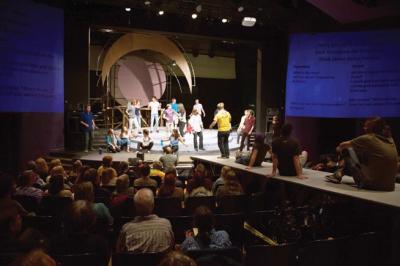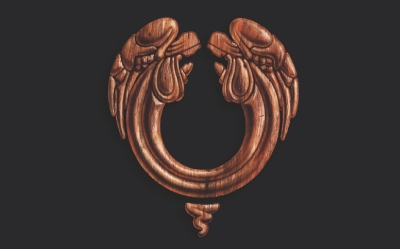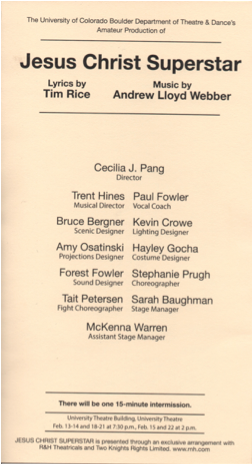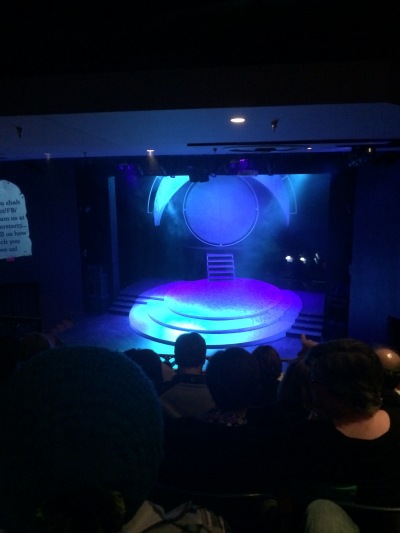Visit my artist site here.
Project 3
To view the site for Multiple Perspective Film, click here.
Project Prospectus
As a producer, my primary concerns are the story and message of a film and how those elements reach an audience. I plan to propose the implementation of multiple perspective films – writing and shooting a movie from multiple perspectives (likely those of the hero and antagonist), and allowing an audience to select from which viewpoint they want to hear the story. At first the multiple perspective films will only be offered in one version or another, and viewers will have to select which perspective they wish to see upfront. However, as popularity of this new style of film grows, I intend to expand upon the idea, filming even more perspectives and creating a more interactive format that will allow a viewer to select which perspective they want to see for individual scenes.
Inventio Activity
I find the idea of “interconnectedness” very interesting. I think most contemporary art, as with the production of Jesus Christ Superstar I attended for exercises 2 and 3, employs interconnectedness by incorporating digital media with new technology and classic art. I am not certain what area of the film field I would most like to update, but likely something which involves interaction with the audience, be that the distribution, connection with viewers, etc. The new book Women, Art, and Technology by Judy Malloy would likely have some good ideas from other female artists that would help me to generate a filmic concept to update.
Proposal: Art Praxis Update
As a film major, the most interesting element of the University of Colorado’s production of Jesus Christ Superstar was undoubtedly the incorporation of live-feed camera footage. Unlike most theater performances, the CU theater department employed video to provide the audience with a closer, more detailed look at the characters and emotions of the show. While the use of this technology was incredibly advanced for theatrical art, I believe an even greater incorporation of digital media could benefit the production. The “interconnectedness” of various mediums is constantly increasing in this digital world, and applying a digital aesthetic to a classically non-digital channel would greatly advance the modernity and reception of the art (Turner-Rahman). Projecting live footage on the wall and stage props during multiple scenes, instead of simply those considered most significant, would allow the audience to more easily follow the show. The video feed enables the viewers to see close-ups of the actors and their stunning performances, adding a more personal touch to a format that is typically intended for a large group of people. Furthermore, utilizing staged cameras held on tripods as opposed to in the hands of a mobile crewmember, could add a greater sense of professionalism. Employing multiple cameras would also remove the awkward moments in which the projected footage is not showcasing an actor, but the erratic movements of a cameraman rushing to set up the next planned shot. However, as an artist, I also understand that the desire to produce something new cannot overshadow the ultimate aim of creating art.

A photo from the Daily Camera showcases the projection screens employed in the performance during a rehearsal of Jesus Christ Superstar. Unfortunately, due to theater rules, it was not possible to capture a photograph of the live video feed during the actual production.
Jesus Christ Superstar is a theatrical musical intended to be viewed by a live audience. While the added use of technology may make the show more interesting and allow the overall message to more easily reach a 21st century audience, it cannot overpower the performance. If the actors wished for the technology to be the sole portal meant to convey their performance, then they would be better suited for life in the film industry. Yet, these are live players. The incorporation of camera footage should be enough to enhance the presentation without removing the theatrical qualities that have made live theater popular for the past multiple centuries. With great practice and careful use, I believe live theater and live footage working together could create a greater product that would appeal to those living in a digital era, while still paying homage to the genre’s artistic roots.
Works Cited:
Turner-Rahman, Greg. “Sharing Styles: New Media, Creative Communities and the Evidence of an Open Source Design Movement.” The Fibreculture Journal 7 (2005). Web. 19 Apr. 2015. .
Jesus Christ Superstar Review
Although I am not a theater major, I do greatly enjoy seeing both plays and musicals. CU Boulder’s production of Jesus Christ Superstar was no exception. The catchy tunes, impressing vocals, and hilarious antics of one King Herod made for an entertaining night. However, as I am not an expert on musical theater, I do not wish to judge the performance on its theatrical merit, but analyze it using my unique filmic perspective.

Logo image for the performance taken from the CU Theatre & Dance department website
Unlike film, a theater production is viewed from a singular, straight on, wide-angle perspective. The limits of this viewpoint are obvious. The audience’s eye cannot be drawn to a certain detail by the angle of a camera, but must constantly view the scene as a whole. Sitting in the very back of the balcony, as the opening night’s performance was a sold out show, it was difficult to see any of the action occurring downstage. While frustrating to someone who is used to utilizing camera equipment to ensure visualization of every detail, the stagnant perspective truly allowed for the actors’ performances to shine. Were the production in a motion picture format, I would likely have recommended the use of multiple close ups and angles to add interest to some of the action-lacking scenes. Yet, in the musical version, the actors simply stood on stage, occasionally moving about, belting their hearts out. This method was incredibly effective for the theater format, as my attention was captured for the entire performance, particularly during the marvelous solo numbers voiced by Jesus, Judas, and Mary Magdalene.

Scanned copy of the cover of last night’s program
Another stark contrast between film and theater is the use of scenery. Some theatrical productions employ copious, detailed backdrops to transport the audience into the setting. However, in the case of Jesus Christ Superstar, the director chose, once again, to allow the actors and their performances to do the legwork. The stage consisted of a three-tiered platform with a large round backdrop sitting underneath a sideways crescent moon decoration. Although this scenery may sound quite plain, it’s lack of detail did not in any way stunt the performance. In a movie version, I would employ a variety of different settings with real flora and architecture to more clearly iterate the tale and remove some of the responsibility for moving the story along from the actors’ shoulders. Yet, the CU theater students bore the burden of carrying the plot incredibly well, telling the story of Christ almost entirely without use of backdrop. The one instance where the scenery truly took center stage was at the conclusion of the performance, when the round background piece split into fourths, revealing an opening that perfectly framed Jesus on his crucifix. While in a motion picture, the use of low angles and a real life crucifix on a hill would have been employed to create a more realistic effect, the utilization of the scenery in the theater generated a much more raw, sentimental result that did not require technology to trigger the audience’s emotions.

Photo taken of the scenery prior to the beginning of the performance
The final obvious difference between theater and film is that of special effects. A movie has the latest and greatest computer technology at its disposal. The theater performers were reliant upon more basic effects, utilizing a classic trapdoor that allowed Judas to descend into Hell and the opening background piece that not only framed the crucifix, but also permitted characters to dramatically enter and exit a scene. The cinematic version of this tale would be able to use computer-generated images alongside graphic effects to add a sense of realism. Yet, realism was not the aim of this musical. Therefore, the more simple effects did in fact achieve the intended goals of fostering emotion and creating drama. The technique that generated the greatest amount of drama was, for a theater production, rather high tech. Crew members followed the cast with a live-feed camera projecting on the walls and crescent moon decoration, revealing close up shots that an audience would likely have seen in a film format. I greatly enjoyed this cross-over of the two artistries, and thought the employment of this practice only furthered the fantastic quality of what seemed an incredibly professional show.
Jesus Christ Superstar runs at the CU University Theater from April 10th – April 19th.
You can purchase tickets here.
Movie Review Example
As I am planning to see the CU Boulder theater department’s adaptation of Jesus Christ Superstar and review it from the perspective of a filmmaker, examining how the story would be different in a cinematic format, I chose to provide an example review of another film adaptation of a Broadway musical. Stephen Sondheim’s Into the Woods was released on the big screen this past December. The Los Angeles Times‘ review of the film can be found below.
Review: The trip ‘Into the Woods’ is spooky, serious, delightful – LA Times
Artistic Inquiry
Artistic inquiry, or the idea of art as research, is featured prominently in film art. When making a movie, an artist constantly learns through doing – through trial and error. A shot is set up, filmed, and then reviewed. If color is poor, lighting too dark, etc., the shot must be re-filmed, adjusting for error. The same process applies to actions in both pre- and post-production. Writing may need to be altered, as may the editing style. Regardless of in what area of film an artist is involved, their creation of art requires adjustment. By making cinematic art, an artist is performing artistic research. They are learning what methods work best for their particular art piece, and continuously altering their process to account for the new knowledge they are gaining. Artistic inquiry in film is a constant process. No one motion picture is the same as another, and the various techniques and methodologies used to create films must constantly adjust for the particular style or effect a filmmaker is aiming to achieve. While some basic principles may be universal, the specificities must remain variable. No filmmaker is ever truly done learning. As long as film art continues to be produced, artistic inquiry will remain employed, and the knowledge and research of film artists will continue to grow.
Rhetorical Analysis
To read my rhetorical analysis of Filmmaker Magazine, select the menu button and then Rhetorical Analysis from the Project 2 dropdown menu, or simply click here.
Sharing the Group Blog
I shared the film group blog with my friends on Facebook. Although not all of my Facebook friends are interested in the film field, I believe that reaching a wide audience of all ages will encourage outside interest in the topic. I also shared the blog with former broadcast classmates via email, as I know all of them have some interest in the area and are closer to our group’s target audience.
